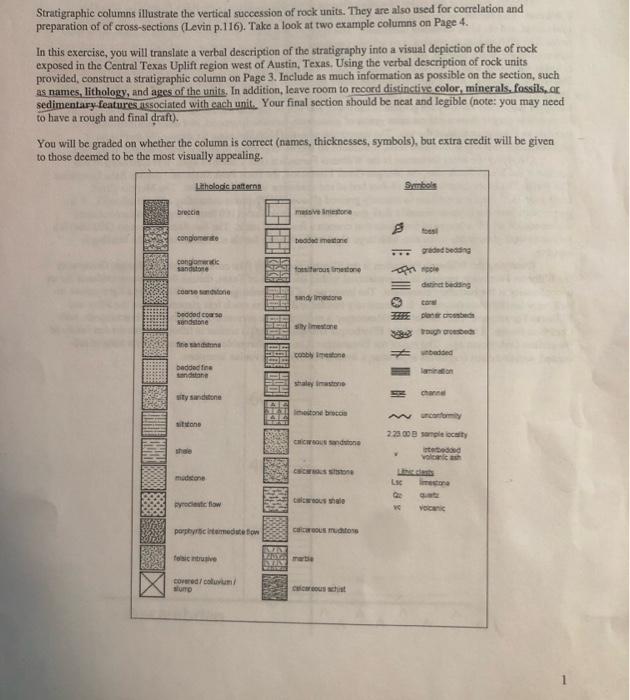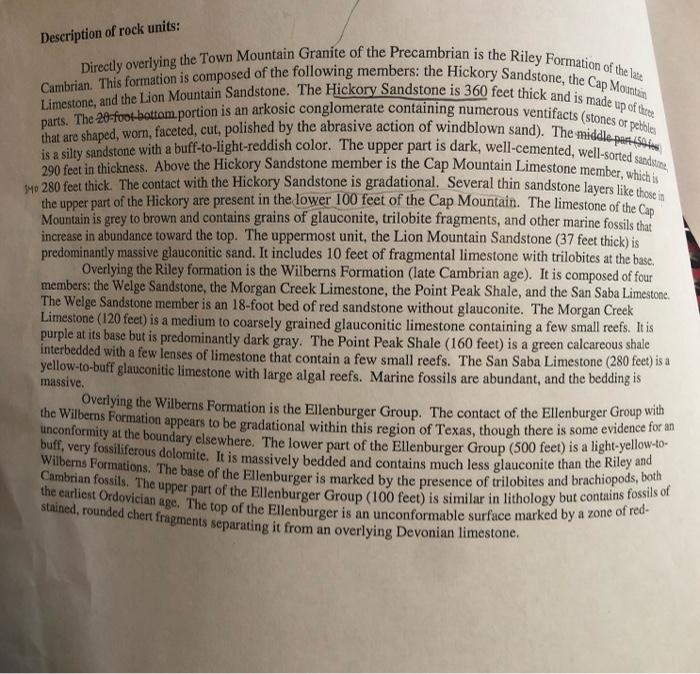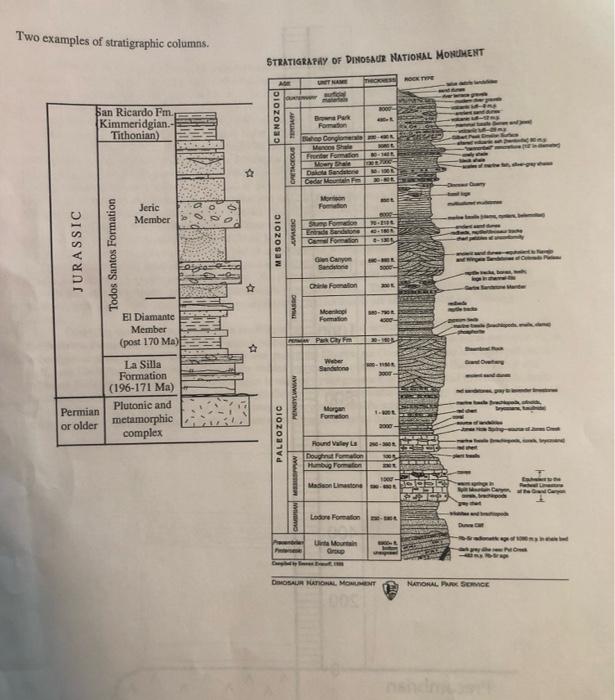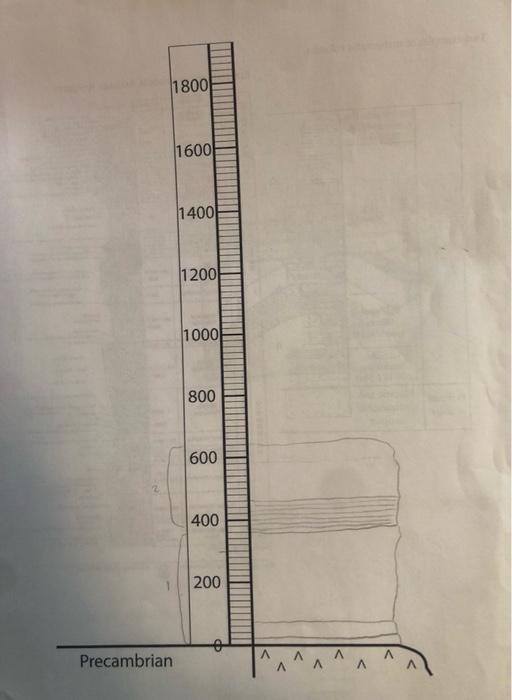a Stratigraphic columns illustrate the vertical succession of rock units. They are also used for correlation and preparation of of cross-sections (Levin p.116). Take a look at two example columns on Page 4. In this exercise, you will translate a verbal description of the stratigraphy into a visual depiction of the of rock exposed in the Central Texas Uplift region west of Austin, Texas. Using the verbal description of rock units provided, construct a stratigraphic column on Page 3. Include as much information as possible on the section, such as names, lithology, and ages of the units. In addition, leave room to record distinctive color, minerals, fossils.ar sedimentary features associated with each unit. Your final section should be neat and legible (note: you may need to have a rough and final draft). You will be graded on whether the column is correct (names, thicknesses, symbols), but extra credit will be given to those deemed to be the most visually appealing. Lithologic pattern Symbols broccio med venne Boost conglomerat det mestane congioni orded being no forous limestone distinct bedding Cone and more bodood corso sandstone Sly limestone E per cond Stugor bedded fine come bedded in indian Shalimat sity sandstone stond be conomy tione 223 00 B samplecat CCU Sanne hale wali Stone medone Lc Pric flow usha Volan porphyricletamedue to CIRCUS Moss totive corred/com! som Caschi Description of rock units: Directly overlying the Town Mountain Granite of the Precambrian is the Riley Formation of the Vat Limestone, and the Lion Mountain Sandstone. The Hickory Sandstone is 360 feet thick and is made up of the Cambrian. This formation is composed of the following members: the Hickory Sandstone, the Cap Montan that are shaped, worn, faceted, cut, polished by the abrasive action of windblown sand). The middle part. 544 parts. The 20-foot-bottom.portion is an arkosic conglomerate containing numerous ventifacts (stones of petites 290 feet in thickness. Above the Hickory Sandstone member is the Cap Mountain Limestone member, which is is a silty sandstone with a buff-to-light-reddish color. The upper part is dark, well-cemented, well-sorted sandson 540 280 feet thick. The contact with the Hickory Sandstone is gradational. Several thin sandstone layers like these in the upper part of the Hickory are present in the lower 100 feet of the Cap Mountain. The limestone of the Cap Mountain is grey to brown and contains grains of glauconite, trilobite fragments, and other marine fossils that increase in abundance toward the top. The uppermost unit, the Lion Mountain Sandstone (37 feet thick) is predominantly massive glauconitic sand. It includes 10 feet of fragmental limestone with trilobites at the base, Overlying the Riley formation is the Wilberns Formation (late Cambrian age). It is composed of four members: the Welge Sandstone, the Morgan Creek Limestone, the Point Peak Shale, and the San Saba Limestone The Welge Sandstone member is an 18-foot bed of red sandstone without glauconite. The Morgan Creek Limestone (120 feet) is a medium to coarsely grained glauconitic limestone containing a few small reefs. It is purple at its base but is predominantly dark gray. The Point Peak Shale (160 feet) is a green calcareous shale interbedded with a few lenses of limestone that contain a few small reefs. The San Saba Limestone (280 feet) is a yellow-to-buff glauconitic limestone with large algal reefs. Marine fossils are abundant, and the bedding is massive Overlying the Wilberns Formation is the Ellenburger Group. The contact of the Ellenburger Group with the Wilberns Formation appears to be gradational within this region of Texas, though there is some evidence for an unconformity at the boundary elsewhere. The lower part of the Ellenburger Group (500 feet) is a light-yellow-to- buff, very fossilferous dolomite. He is massively bedded and contains much less glauconite than the Rileye Wilberns Formations. The base of the Ellenburger is marked by the presence of trilobites and brachiopodes, bendron Cambrian fossils. The upper part of the Ellenburger Group (100 feet) is similar in lithology but contains fossils of the earliest Ordovician age. The top of the Ellenburger is an unconformable surface marked by a zone of red- stained, rounded chen fragments separating it from an overlying Devonian limestone, Two examples of stratigraphic columns. STRATIGRAPAY OF DINOSAUR NATIONAL MONUMENT ROCK w San Ricardo Fm Kimmeridgian.- Tithonian CENOZOIC Budak Formator ho Donglome Mandag Fri Formation M Dato Sandalen Colar - CRETACEOUS M Foton Jeric Member . re Gafomation MESOZOIC JURASSIC 0-10 Todos Santos Formation Gay Sandton 3000 Foton THANO Moen Formation El Diamante Member (post 170 M) PERC Weber Sandton La Silla Formation (196-171 Ma) Plutonic and metamorphic complex Permian POWSTANIAN PALEOZOIC Morgan Formation 100 or older 2000 N- Round We Download mbug Foton 190 Mono London Formation -- Lina Mora Or Ir! DOSAUR RATIONAL MONUMENT NATIONAL SERVICE 11800 1600 1400 1200) 1000 800 600 400 200 o Precambrian A A A A a Stratigraphic columns illustrate the vertical succession of rock units. They are also used for correlation and preparation of of cross-sections (Levin p.116). Take a look at two example columns on Page 4. In this exercise, you will translate a verbal description of the stratigraphy into a visual depiction of the of rock exposed in the Central Texas Uplift region west of Austin, Texas. Using the verbal description of rock units provided, construct a stratigraphic column on Page 3. Include as much information as possible on the section, such as names, lithology, and ages of the units. In addition, leave room to record distinctive color, minerals, fossils.ar sedimentary features associated with each unit. Your final section should be neat and legible (note: you may need to have a rough and final draft). You will be graded on whether the column is correct (names, thicknesses, symbols), but extra credit will be given to those deemed to be the most visually appealing. Lithologic pattern Symbols broccio med venne Boost conglomerat det mestane congioni orded being no forous limestone distinct bedding Cone and more bodood corso sandstone Sly limestone E per cond Stugor bedded fine come bedded in indian Shalimat sity sandstone stond be conomy tione 223 00 B samplecat CCU Sanne hale wali Stone medone Lc Pric flow usha Volan porphyricletamedue to CIRCUS Moss totive corred/com! som Caschi Description of rock units: Directly overlying the Town Mountain Granite of the Precambrian is the Riley Formation of the Vat Limestone, and the Lion Mountain Sandstone. The Hickory Sandstone is 360 feet thick and is made up of the Cambrian. This formation is composed of the following members: the Hickory Sandstone, the Cap Montan that are shaped, worn, faceted, cut, polished by the abrasive action of windblown sand). The middle part. 544 parts. The 20-foot-bottom.portion is an arkosic conglomerate containing numerous ventifacts (stones of petites 290 feet in thickness. Above the Hickory Sandstone member is the Cap Mountain Limestone member, which is is a silty sandstone with a buff-to-light-reddish color. The upper part is dark, well-cemented, well-sorted sandson 540 280 feet thick. The contact with the Hickory Sandstone is gradational. Several thin sandstone layers like these in the upper part of the Hickory are present in the lower 100 feet of the Cap Mountain. The limestone of the Cap Mountain is grey to brown and contains grains of glauconite, trilobite fragments, and other marine fossils that increase in abundance toward the top. The uppermost unit, the Lion Mountain Sandstone (37 feet thick) is predominantly massive glauconitic sand. It includes 10 feet of fragmental limestone with trilobites at the base, Overlying the Riley formation is the Wilberns Formation (late Cambrian age). It is composed of four members: the Welge Sandstone, the Morgan Creek Limestone, the Point Peak Shale, and the San Saba Limestone The Welge Sandstone member is an 18-foot bed of red sandstone without glauconite. The Morgan Creek Limestone (120 feet) is a medium to coarsely grained glauconitic limestone containing a few small reefs. It is purple at its base but is predominantly dark gray. The Point Peak Shale (160 feet) is a green calcareous shale interbedded with a few lenses of limestone that contain a few small reefs. The San Saba Limestone (280 feet) is a yellow-to-buff glauconitic limestone with large algal reefs. Marine fossils are abundant, and the bedding is massive Overlying the Wilberns Formation is the Ellenburger Group. The contact of the Ellenburger Group with the Wilberns Formation appears to be gradational within this region of Texas, though there is some evidence for an unconformity at the boundary elsewhere. The lower part of the Ellenburger Group (500 feet) is a light-yellow-to- buff, very fossilferous dolomite. He is massively bedded and contains much less glauconite than the Rileye Wilberns Formations. The base of the Ellenburger is marked by the presence of trilobites and brachiopodes, bendron Cambrian fossils. The upper part of the Ellenburger Group (100 feet) is similar in lithology but contains fossils of the earliest Ordovician age. The top of the Ellenburger is an unconformable surface marked by a zone of red- stained, rounded chen fragments separating it from an overlying Devonian limestone, Two examples of stratigraphic columns. STRATIGRAPAY OF DINOSAUR NATIONAL MONUMENT ROCK w San Ricardo Fm Kimmeridgian.- Tithonian CENOZOIC Budak Formator ho Donglome Mandag Fri Formation M Dato Sandalen Colar - CRETACEOUS M Foton Jeric Member . re Gafomation MESOZOIC JURASSIC 0-10 Todos Santos Formation Gay Sandton 3000 Foton THANO Moen Formation El Diamante Member (post 170 M) PERC Weber Sandton La Silla Formation (196-171 Ma) Plutonic and metamorphic complex Permian POWSTANIAN PALEOZOIC Morgan Formation 100 or older 2000 N- Round We Download mbug Foton 190 Mono London Formation -- Lina Mora Or Ir! DOSAUR RATIONAL MONUMENT NATIONAL SERVICE 11800 1600 1400 1200) 1000 800 600 400 200 o Precambrian A A A A










